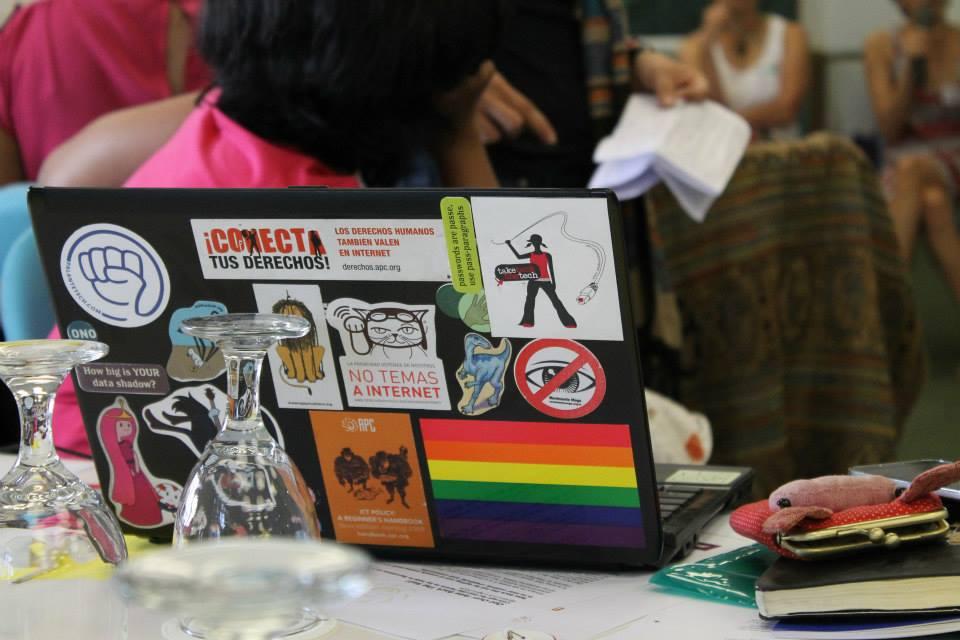
Discourses on issues of safety are not new to feminists. Strategies to resist sexual harassment in the office, verbal abuse on the streets, physical violence in the home, shaming in social spaces and sexualised threats to women human rights defenders are continually being revisited and reworked. Often this abuse is about the silencing of women’s voices and the marginalisation in social and political spaces. Given the blurred lines between online and offline realities and activism, being safe and secure in both universes is critical.
Many feminists are not securing themselves online nor are not aware of the tactics and tools to create a safe experience for themselves and by extension those in their networks. The irony is that with social media, it is easy to sign up and sign away a lot of your personal information via Facebook, Twitter, Pinterest, Tubmlr or with mobile phone applications like What’sApp. But it’s harder and more time-consuming to know how to secure oneself online. And yet we cannot have one without the other.
In April a group of activists gathered to dialogue and dream, explore and develop a collective understanding of what a feminist internet looks like. Feminist and queer activists, people involved in internet rights and policy reform from diverse organisations and networks reflected, problematised and troubled issues of gender, sexuality and the internet. Invariably, discussions of sexual expression and women’s activism online necessarily includes questions around “harmful content”, pornography, “hate speech”, gender-based violence and sexual rights. One of the goals of the meeting was to find, within a sex-positive queer framework, an agreement on core feminist principles for a transformative internet, in order to develop a set of evolving Feminist Principles of the Internet. Fundamental to this is an exploration of what the digital threats are being experienced by queer activists and how these can be mitigated. Participants spent time looking at the platforms and people, the spyware and malware that affect our sense of insecurity and the realities of online activism.
Through a process of threat modelling, we created fictional avatars of various activists, we built profiles of what activists use the internet for, online threats experienced and what security responses could be. The thing that became obvious about responses to digital (in)security is that there is no “one size fits all” response to being safe online. Nor is it advisable to separate online from physical safety.
Examples of the thinness of the binary between online and offline
Digital safety is both organisational and individual. Here are two experiences which show insecurities and responses and the need for legislation to protect and offer redress to digital threats.
The case of Women in Black Belgrade shows how online threats affects an offline sense of insecurity. Women in Black in Belgrade organised a “We Remember / Kujtojmë” on the 15th anniversary of the crimes committed over Albanian civilians in Kosovo in March of this year. The next day, via Facebook, a government official called for football hooligans and others to “join forces and give it to those who deserve thrashing”. Women in Black responded by soliciting the help of The Lawyers Committee for Human Rights. This unleashed vitriol and sexualised threats of rape and “bullets through the forehead” and warnings of lynchings towards Women in Black via online spaces. Given the publicity of this, when Women in Black organised a legal street protest, a large number of heavily-armed police officers were present and caused huge anxiety in the residents of the area. This resulted in Women in Black have been asked to vacate the office in the building they have rented since 1997. Because Women in Black have consistently reported the online threats, with not much success at redress, this has further enraged both state and non-state actors and the digital threats of violence continues.
A successful example of resisting digital harassment is a case in South Africa of a woman being sexually threatened via SMS by an ex-partner resulted in her feeling deeply unsafe and moving from her home to live with a friend. The digital threats made her sense of personal safety very fragile. She was taken to a police station where the police were aware of the new anti-harassment law which includes recourse to the law for protection from sexual harassment – including harassment via SMS or e-mail and obtain protection orders. The threats stopped after this which enabled the woman to regain a sense of autonomy and safety.
Misogyny and abuse is systemic in online spaces and creates legitimate insecurity amongst feminists who want not only to claim the internet as a safe space but also to transform the power dynamics and challenge dominant digital narratives. Threats come from different places and people and are not confined to the TRolls who’s intent is to create disharmony, discord and often fear.
Surveillances, data interception, invasions of privacy are ever-present realities for citizens and in particular for activists. As sexual rights activists and people using the internet for creative sexual expression and pleasure we want to access, create and explore online without fear of censorship and moral policing.
We need to fight back and be kick-ass feminists and secure ourselves online! Although the analogy is repeated often – it’s still true – we need to take back the tech as we take back the streets.
A tweet sent to #imagineafeministinternet by Nadine Moawad@nmoawad says:
“We must critique online feminist activism even as we recognize the value of it.”
True! And unless we claim our power and take on issues of digital security, our presence and claiming of the internet as our space, is tenuous.
A great infographic produced by the EROTICS project who undertook a global survey showed the 98% of sexual rights activists say that the internet is an important public sphere for advancing sexual rights. The respondents reported violations such as receiving violent or threatening messages, technical damage, intimidation, hacking, blocking and filtering and experienced them on a variety of platforms. So while we find the internet a critical and empowering space, the threats are real and understanding these essential to our activism.
One of my favorite tweets from #imagineafeministinternet goes like this:
jac smk @jhybe RT @manzibarr Things feminists didnt foresee “While we were gaining access some others were gaining access to us” #imagineafeministinternet
The right to access to the internet is still a major site of advocacy in feminist internet rights work given the huge number of women who still do not have access or reliable, affordable and open access to the internet. However, once we have access, who is accessing us? A great question and a point we need to take very seriously.
So we’ve established that (a) the internet is an amazing space to have access to and (b) it is a major site of misogyny, abuse, surveillance and the moral majority is trying to police it and © that feminists are creating amazing initiatives like #imagineafeministinternet to Take Back the Tech! So (d) how do we become kick-ass ninja feminists and secure ourselves?
First you should read the article by Rohini Lakshane called Imagining a digitally secure, feminist internet where she speaks to the consequences of not securing information.
Second read through some resources on Take Back the Tech Be Safe section of the website. There are explanations on different insecurities and practical steps to take to secure yourself online. Read Security-in-a-box and work through the chapters to protect yourselves and your comrades.
Third, discuss digital safety in your organisation and draw up an organisational secure online communication policy. Each person in the organisation needs to be a part of this and not just the communication or tech-support people. Talk about online traces in your families and communities and learn about digital safety.
Fourth, go to https://myshadow.org and “see which digital shadows you cast and how to make them smaller. Learn how you, your friends and family stay safe and sound in the digital world.”
Fifth, as we commit to #imagineafeministinternet, we must build a cadre of technically confident internet feminists who can train and build awareness around digital security and grow the number of online ninja feminists.
And as Grace Hopper said (she was the first compiler for a computer programming language, developer of UNIVAC I and COBOL, and coiner of the terms “computer bug” and “debugging.”)
“A ship in port is safe, but that is not what ships are for. Sail out to sea and do new things.” We should sail out into digital spaces and make a loud noise and not be silenced but be aware of the amazing potentials and the dangers but be secure.
Responses to this post
There is No Way Women Can Secure themselves on the Internet unless the have their own Satelite and and Network providers. Why do i say that? The case of hacking into People’s email accounts and sensorship of Black and African Women and internet activists is the Best exemple ever.
There is No where Women from Africa participating on Internet activities Can ask for Intervention nor support related to abuse of Human right and diorivation and racism in Denmark due to Participation on Internet events via Facebook Twitter CNN and other. Online activities on Social pages pages is becoming as dangerous as it was to be an Atropologist in Second World War or being a Political betrader of certain Countries such as Denmark in 2014.
The internet motivate Women Online activists to tell their story because they believe on Freedom of speech equality Human Rights. Peculiar. When Women get in troubles there is No country No Diplomatic Institution they Can ask for support.
The all Thing about the Internet and social medie must be rethinked. If internet, social media, digital libraries are to be a succes and carriers out by the most aktive women we must form a ny country the Internet Country able to issue Deplomatic Passports and save Women on the net Worldwide.
- Add new comment
- 9570 views






Add new comment